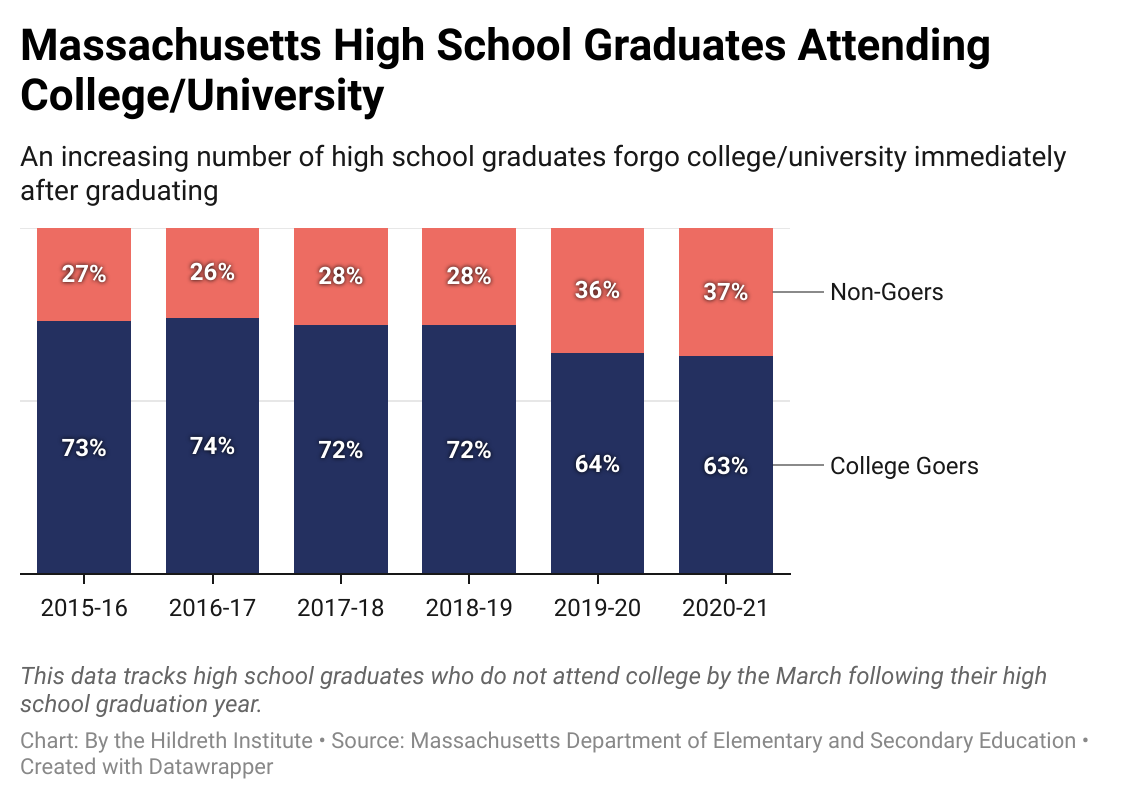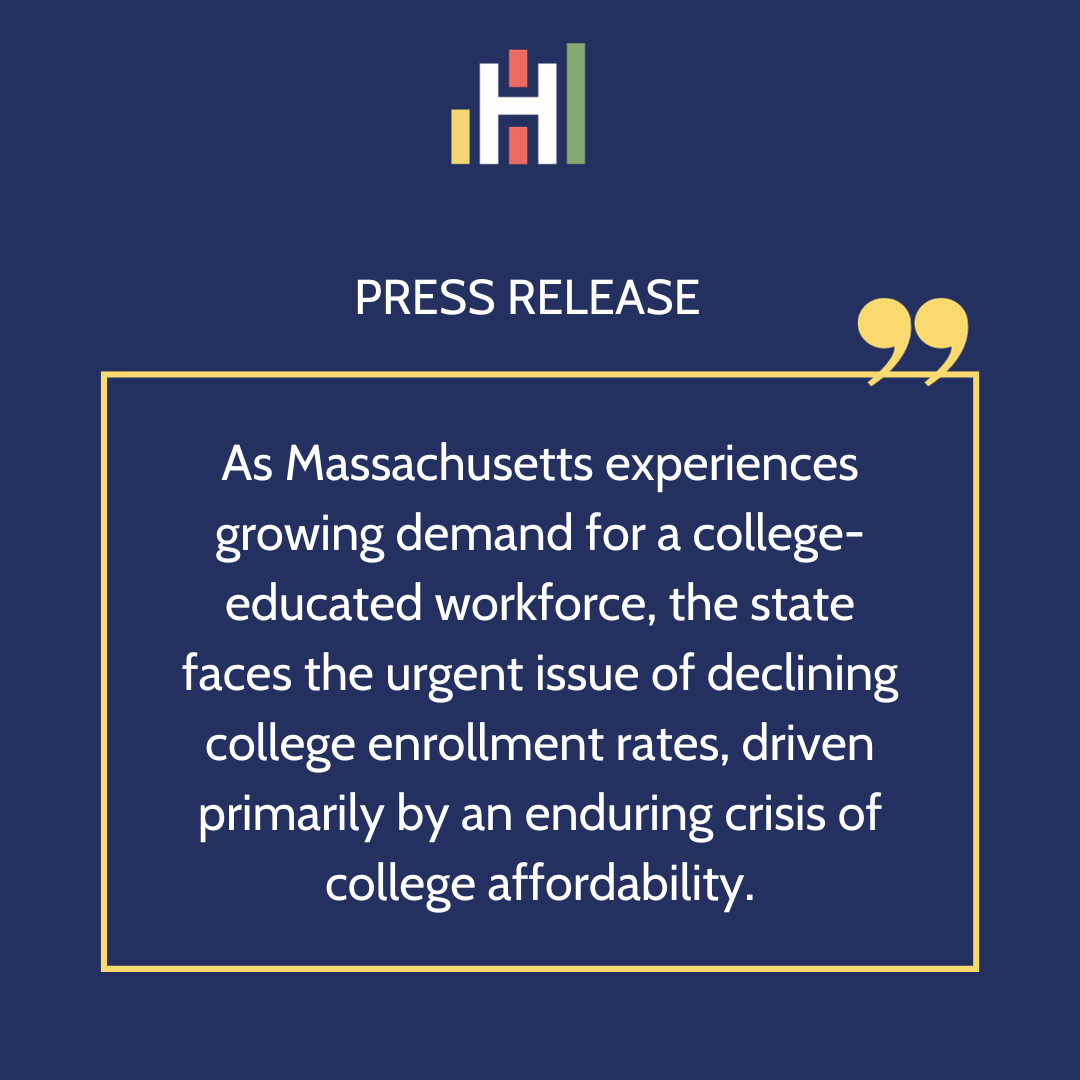Seizing the Opportunity:
Reversing Enrollment Declines in Higher Education
September 2023
Executive Summary
Despite rising high-school graduation rates contributing to a larger pool of potential college students and a growing demand for a college-educated workforce, Massachusetts is faced with a decline in college enrollment driven by the enduring crisis of college affordability. A decade ago, despite emerging skepticism due to high costs, Americans still overwhelmingly viewed higher education as a good investment and beneficial for the country, with parents across political lines sharing the expectation that their children would pursue a college education. However, a decade later, rising costs and student debt have significantly reduced both the perceived and actual value of a college education, leading to declining confidence in higher education as a pathway to financial security.
In our previous reports, we strongly cautioned about the serious negative effects of our state's policies on public higher education. State funding cuts have resulted in higher tuition and fees, while the state’s disinvestment in scholarship aid has made it increasingly harder for students to afford college, discouraging many from considering the idea of getting a higher education degree.
However, there is a silver lining in Massachusetts. A robust consensus has emerged among the executive branch, legislature, and administration regarding the paramount importance of access to and success in higher education. The FY24 budget saw a praiseworthy influx of funding from the new fair share amendment revenues. And, even before this allocation, the legislature and administration showcased their commitment by embarking on a rigorous, equity-focused introspection, setting the stage for a more inclusive future.
This report, along with its accompanying policy brief, delves into the urgent issue of declining college enrollment in Massachusetts. This trend poses a risk to our workforce development, economic growth, and the vitality of our higher education institutions. By understanding which student demographics are most affected and which education sectors are hit hardest, we aim to offer actionable policy recommendations for decision-makers.
Key Findings:
Rising School Graduation Rates: Massachusetts has seen an increase in high school graduation rates over the past decade that transcends racial and socio-economic categories. This establishes a pipeline of a larger and diverse pool of potential college students, with approximately 5,000 more graduates compared to 2012.
Decline in Immediate College Enrollment: Despite increased high school graduation rates, fewer Massachusetts high school graduates are enrolling in college immediately after high school. Enrollment dropped from 73 percent in 2015-16 to 63 percent in 2020-21, disproportionately affecting students of color and those from low-income backgrounds.
Racial Disparities in Enrollment: The decline in immediate enrollment is particularly pronounced among Hispanic and Black students, highlighting racial disparities exacerbated by historical disadvantages and structural racism.
Enrollment Discrepancies Between Income Groups: The gap in college enrollment between low-income and affluent students has increased from 21 percent to 30 percentage points, aggravating socioeconomic inequalities.
Impact on Higher Education Sectors: Enrollment at in-state colleges and universities has declined, while out-of-state institutions have remained stable. Community colleges, serving minority and low-income students, have experienced the most significant loss.
Decline in Overall College Attendance: Beyond immediate enrollment, overall college attendance has decreased at the state’s community colleges and universities, particularly among minority groups. Black and Hispanic students saw steeper declines in community college and state university enrollment.
Rising Non-Completion Rates: The observed decline in student populations at community colleges and state universities extends beyond just a reduction in freshman enrollments. Our findings suggest an increasing trend of students not completing their degrees, emphasizing the pivotal role that affordability plays in this trend.
Recommendations:
To counteract falling college enrollment and retention rates, the state must seize the opportunity to swiftly tackle the issue of educational affordability across all tiers of higher education, not just within community colleges. The recent passage of the Fair Share Amendment provides a timely influx of revenue partly earmarked for public higher education, offering an unprecedented chance for comprehensive reform. By streamlining existing grants and scholarships into larger, more straightforward financial aid programs, the state can directly address the escalating unmet financial needs of students and pave the way for increased college accessibility and enrollment.
Streamline existing grants and scholarships
Consolidate state-sponsored financial aid initiatives into more streamlined, comprehensive programs. This unified approach will clearly convey the state's dedication to offering affordable, high-quality higher education credentials.
Expand on the tuition-free community college commitment with the goal of achieving a debt-free program
Reevaluate the "last-dollar" grant approach, which has regressive impacts on lower-income students.
Shift focus from covering only tuition and fees to meeting students’ full "unmet financial need," which includes living expenses, textbooks, and transportation.
Allocate financial aid by calculating students' unmet financial needs based on the full cost of attendance to effectively reduce or eliminate the need for student loans.
Expand the debt-free Commitment to 4-year public degrees
Broaden affordability measures to include 4-year institutions to prevent educational inequalities based on socio-economic and racial lines.
Develop a comprehensive strategy that promotes equitable access across all educational levels and institutions.
Provide comprehensive student support services
Invest in well-rounded student support services such as academic advising, mental health assistance, and career guidance to aid in student retention and success.
Support of equity in higher education admissions
Discontinue practices like legacy admissions and early decision policies, which perpetuate socio-economic and racial disparities in college admissions.
Engage community organizations and high schools
Partner with community organizations for targeted outreach to underrepresented minority and economically disadvantaged students.
Enhance financial support for high-school counseling services to inform students about new affordability initiatives and promote a college-bound mindset.
Based on our findings, we developed an accompanying policy brief which includes a range of policy options along with their respective advantages and disadvantages for decision-makers interested in creating an ambitious equity centered higher education strategy.





